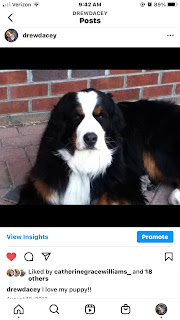I downloaded Instagram when I was 11 after asking my mom's permission. I was in sixth grade and I think the app had only been out a few months at the time, but it was what all the cool kids were doing, so I wanted to be a part of it. I remember the feeling of nervous excitement as I posted something for the first time. I was afraid of what people might say or that I was "doing it wrong." As I sat in my room as a sixth grader I was alone, but I had never felt so vulnerable.
I do not have a personal website, but I do have just about every social media. Instagram is definitely my most used. I downloaded Snapchat not much after that and is used probably just as often. I have a Twitter and Facebook but rarely go on it, it's more for news or networking over anything else. In last place is defiantly the blogging sites that I haven't checked out since 2013, WattPad and Tumblr.
As we can see a few things have changed over the years:
The first thing to pop up when "Drew Dacey" is googled is my Facebook profile. Next are a few other people's instagrams along with my own. Interviews and published work I've done for a local media company pops up under that. It's curious to me that my Facebook is the first result considering I rarely engage. That could be a testament to the power Facebook hold over all the Internet.
My Instagram is where people can find most things about me. Throughout high school and into college I've share pretty deeply emotionally personal things on my page. This was in an effort to combat the lack of true vulnerability I was seeing on the Internet every day. This being said, I've always looked at it more like a personal blog than anything else. I'm a leader in many different spheres of my life. For example, I lead high schoolers through YoungLife and I've always wanted to remain transparent about who I am on the Internet in order to create a better bond in person. I think it's true that I follow, or have at least seen, someones Instagram before I meet them. For this reason, my profile is public which anyone can see all of my photos without having to follow me.
Looking back, this is potentially really dangerous. Doing a quick swipe through my profile could tell you where I'm from, where I go to college, my general interests and organizations I'm a part of. As well as connect you to all my best friends and past boyfriends. Yikes. I'm not sure keeping a vulnerable, open image is worth having a stranger with Mal-intent have that information.
It's also frightening to think that I've given my phone number and email to all my social media platforms for them to "keep the account as secure as possible." I have linked my organizations and other social media sites as well as my parents pages. My parents have always been in the public eye, my dad even running for US Congress a few years back. There were death threats made to my whole family, including myself, and the vulnerability of my social media most likely didn't dissuade that from happening.
I feel attached to the Internet, and most days I'm not upset about it. I have fun with social media. There's a lot of positive things to say about how it brings people together and can rally support for important causes or simply supporting each other. There is for sure something to say about the detrimental affect it can have on mental health and general focus.
I have felt left out and pressured to post certain things depending on what others in my social circle post. In a time of so much alone time, like the COVID-19 issued quarantines, there's been a lot of time to look at those who are "doing well" and compare myself to them. I think social media is taking a toll on men and women individual image and confidence all over the western world. We think about what we should wear for a post more than we think about those in our lives that we care for in a day. Yes it's making us lonely and depressed, that's something we've known for years, but I'm afraid its making us less aware of loving each other as well. In the future I will strive to create a safer online footprint for myself and to be aware of how my mental health and actions, as well as those I love's health and actions, are affected by our use of social media.





